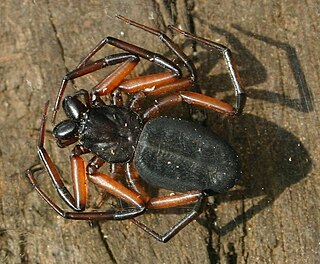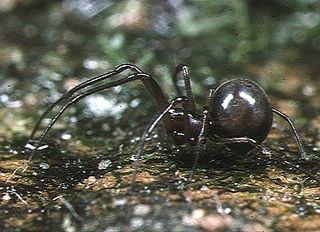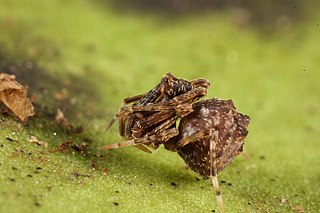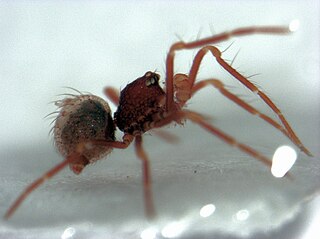
The family Dipluridae, known as curtain-web spiders are a group of spiders in the infraorder Mygalomorphae, that have two pairs of booklungs, and chelicerae (fangs) that move up and down in a stabbing motion. A number of genera, including that of the Sydney funnel-web spider (Atrax), used to be classified in this family but have now been moved to Atracidae.

Oonopidae, also known as goblin spiders, is a family of spiders consisting of over 1,600 described species in about 113 genera worldwide, with total species diversity estimated at 2000 to 2500 species. The type genus of the family is OonopsKeyserling, 1835.

Trochanteriidae is a family of spiders first described by Ferdinand Karsch in 1879 containing about 52 species in 6 genera. Most are endemic to Australia though Doliomalus and Trochanteria are from South America and Plator is from Asia. Platyoides species exist in southern and eastern Africa, Madagascar, and the Canary Islands with one species, P. walteri, introduced to Australia.

Orsolobidae is a six-eyed spider family with about 180 described species in thirty genera. It was first described by J. A. L. Cooke in 1965, and was raised to family status from "Dysderidae" in 1985.

Anapidae is a family of rather small spiders with 232 described extant species in 58 genera. It includes the former family Micropholcommatidae as the subfamily Micropholcommatinae, and the former family Holarchaeidae. Most species are less than 2 millimetres (0.079 in) long.

Archaeidae, also known as assassin spiders and pelican spiders, is a spider family with about ninety described species in five genera. It contains small spiders, ranging from 2 to 8 millimetres long, that prey exclusively on other spiders. They are unusual in that they have "necks", ranging from long and slender to short and thick. The name "pelican spider" refers to these elongated jaws and necks used to catch their prey. Living species of Archaeidae occur in South Africa, Madagascar and Australia, with the sister family Mecysmaucheniidae occurring in southern South America and New Zealand.

Holarchaea is a genus of South Pacific araneomorph spiders in the family Anapidae, and was first described by Raymond Robert Forster in 1955. As of May 2019 it contains only two species, H. globosa and H. novaeseelandiae, but there may still be undescribed species in New Zealand.

The Micropholcommatinae are a subfamily of araneomorph spiders in the family Anapidae. They were previously treated as the family Micropholcommatidae. Micropholcommatins are extremely small, with body lengths typically between 0.5 and 2 mm. They are usually found among leaf litter or moss.

Coneweb spiders (Diguetidae) are six-eyed haplogyne spiders that live in tangled space webs, fashioning a cone-like central retreat where they hide and lay eggs. It is a small family, containing only two genera split between a range in the Southwestern United States and Mexico and a range in South America. Members of the genus Diguetia usually build their webs in shrubs or between cactus pads. They have the same eye arrangement as the venomous recluse spiders.
Anopsolobus is a monotypic genus of Polynesian araneomorph spiders in the family Orsolobidae containing the single species, Anopsolobus subterraneus. It was first described by Raymond Robert Forster & Norman I. Platnick in 1985, and is only known from Nelson in New Zealand.
Bealeyia is a monotypic genus of Polynesian araneomorph spiders in the family Orsolobidae containing the single species, Bealeyia unicolor. It was first described by Raymond Robert Forster & Norman I. Platnick in 1985, and is only found in New Zealand.
Dugdalea is a monotypic genus of Polynesian araneomorph spiders in the family Orsolobidae containing the single species, Dugdalea oculata. It was first described by Raymond Robert Forster & Norman I. Platnick in 1985, and is only found in New Zealand.
Tautukua is a monotypic genus of Orsolobidae containing the single species, Tautukua isolata.
Turretia is a monotypic genus of Orsolobidae containing the single species, Turretia dugdalei.

Aotearoa magna is a species of spiders in the Mecysmaucheniidae family. It was first described in 1949 by Forster. As of 2017, it is the only species in the genus Aotearoa, erected by Forster and Platnick in 1984. It is found in New Zealand.
Cantuaria huttoni is a species of trapdoor spider endemic to New Zealand.
Migas distinctus is a species of Mygalomorph spider endemic to New Zealand.
Ascuta insula is a species of Orsolobidae spider of the genus Ascuta. The species is endemic to New Zealand.
Ascuta leith is a species of Orsolobidae spider of the genus Ascuta. The species is endemic to New Zealand.

Phycosoma oecobioides is a species of cobweb spider that is endemic to New Zealand.













